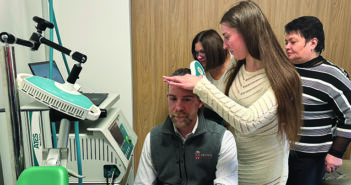In 2001, she asked then-chief of the Division of Infectious Diseases Timothy P. Flanigan, MD, if she could run the viral hepatitis clinic. Though she was soon caring for hundreds of patients, none of them was receiving treatment directly for hepatitis C. “At that time, you were not supposed to treat hep C in people who used drugs and alcohol or who had mental illness—and that was almost all of my patients,” Taylor says. Flanigan pressed her to think differently. “That’s what they used to say about HIV,” he said. “You can’t treat those people.” The thinking about HIV early on had been that people with addiction would not be responsible enough to take their medication correctly, causing the virus to mutate and become resistant to antiretrovirals. If they spread a version of that virus, they could spur a new epidemic that could be harder to treat. Taylor says Flanigan told her: “If we’ve learned anything in this [HIV] epidemic, it’s that there’s no evidence to support that. If people aren’t taking their meds, the onus is on us to help people adhere.”
That was a game changer. Taylor says she had to abandon everything she had been taught and find ways to administer the standard of care for hep C—interferon plus ribavirin—in her patient population. The guidelines had been developed not just because of patient behavior, but because of interferon’s devastating side effects.
“Interferon can make people depressed, suicidal, and homicidal,” Taylor says. The physical side effects may include hair loss, skin rashes, and death. “The fear was tremendous. I didn’t want to cause harm to a patient,” she says.
Taylor decided the only way she could treat her patients would be to watch them closely, monitoring side effects and titrating doses up or down at the slightest sign of distress. She moved the first patient into the only assisted- living facility in the state for adults with HIV/AIDS, which was across the street from her clinic. “I decided to go every single day to see her,” Taylor says, despite the fact that with a population of patients on publicly funded health insurance, it was hardly economically efficient. But, she says, “We were doctors in those days, not business people.”
The patient suffered serious but manageable side effects, and was cured of her hepatitis C. And so Taylor repeated the cycle and built a team of nurses, case managers, and social workers who saw the patients through treatment—a year in most cases. Her compulsive watching became a joke. “My patients always say, ‘Even though interferon was bad, you were worse … watching me, calling me, on top of me,’” she says.
Diana Sylvestre, MD, assistant clinical professor of medicine at University of California, San Francisco and executive director of Oakland’s OASIS Clinic, which also treats people with both addictions and hep C, says Taylor was a pioneer in this work. “She was not a naysayer. She said, let’s figure out how to make it happen, and that’s what it takes in the field we’re in,” Sylvestre says. Taylor’s patients, she adds, are even more challenging since most are coinfected with HIV.




